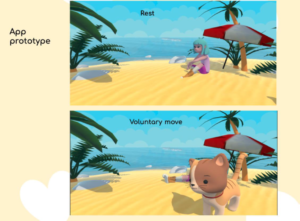Discovering your body
Learn to feel and move your body to build your body map
Phase 1
Type of project: Exploratory research
Disabilities concerned: Mental disability, Motor disability, Multiple disability, Spastic tetraparesis, Global developmental delay
Topics: Communication, Child development, Construction of the subject, Physical and psychological well-being, Quality of life, Development of voluntary motor skills
Status: Completed
The aim is to design and implement an innovative man-machine application by observing how a 5-year-old girl will appropriate it and develop her voluntary motor skills.
Of the neurological disorders affecting voluntary motor control, spastic quadriplegia is the most serious. Affecting 20% of people with cerebral palsy, this syndrome causes significant psychomotor and functional impairment. Developing motor skills is therefore a real challenge.
This project proposes an innovative man-machine application that replaces the lack of somaesthetic information with new information that tells a different story about the body. Thanks to an EMG interface, contractions/spasms are translated by a differentiated visual/sound show (a little cat on a screen / a reassuring melody). This gives children meaningful motor experiences.
The aim is to design and implement this device by observing how a 5-year-old girl will appropriate it and develop her voluntary motor skills.
The first phase focused on the design of the device itself. It turned out that while the prototype developed during the Hackathon provided us with a basis for reflection, the disability-related issues meant that we had to rethink the EMG-appli interface, involving many hours of conceptualisation.
An implementation phase followed in February-March. The system was tailored to Nora’s skills and, above all, to the demands and challenges of her spastic tetraparesis.
After several exchanges between the field and the designers, a professional IT specialist was commissioned to optimise the application.
The final phase involved 9 sessions with the child. Our observations showed that Nora quickly understood what was at stake in these sessions. The number of arm movements in which the little cats appeared increased significantly, while the spasm phases seemed to diminish. The Clair-Bois team also reports that Nora is moving her arms more in the various activities offered on a daily basis. The gesture of pushing an object away also appeared for the first time.

